 No joke.
We did the coolest thing after school yesterday! Our local library hosted a session with Travis Potts, local "Spider Man." Not the kind that swings from building to building rescuing damsels in distress and battling villains, but a hero to the public, just the same. He's a tarantula fanatic, and he brought his pets to share with us.
No joke.
We did the coolest thing after school yesterday! Our local library hosted a session with Travis Potts, local "Spider Man." Not the kind that swings from building to building rescuing damsels in distress and battling villains, but a hero to the public, just the same. He's a tarantula fanatic, and he brought his pets to share with us.
I have a morbid fascination with spiders. I think they are super creepy, but, yet, I can't take my eyes off of them. Kind-of like a train-wreck. And there's Charlotte. Who doesn't love Charlotte? Spiders are completely enchanting. So when we heard that there were going to be spiders at the library, I was completely pumped. Porter, my six-year-old son, was excited, too. And Campbell, my four-year-old daughter, told me she didn't want to go, but I made her, anyway, and when they opened the door to allow us to approach the spiders, she shriveled and cried, but, because I'm such an awesome mom, I drug her in. Yeah, I suck a little. SPOILER ALERT: She lived. And she loved it.
Travis brought four live tarantulas, and we got to view them and ask questions.
He shared all sorts of information about them that I didn't quite absorb because I was keeping my eye on the creepy buggars, but as he talked about them and answered these crazy kid questions, the spiders became less creepy to me, and to Campbell. Porter dove right in. He asked tons of questions, and then when Campbell finally let her curiosity get the better of her, she asked more than tons of questions. I think she may have driven Travis insane. He got a small taste of what I deal with every day:
Excuse me. How much venom do they have? Excuse me. How many spiders do you have? Excuse me. Do they bite? Excuse me. What are their names? Excuse me. I think the baby one is really cute. What is her name? Spidey? Excuse me. What do they eat? Excuse me. How old is this spider? Excuse me. What is her name? Excuse me, excuse me, excuse me...
My daughter is a total chatterbox, but at least she's semi-polite. With the excuse me bit. The first question of hers that Travis addressed was "how many knees does a spider have?" I chuckled a bit because spiders don't have knees. So I made eye contact with Travis to let him know that Campbell was so naive to ask about spider knees. How cute.
Travis answered Campbell's seemingly absurd question and explained in all seriousness that spiders have eight knees. And, better yet, if a leg gets caught in something, they can purposely separate at the knee to preserve themselves and then grow back the leg gradually with each molt. Huh? Yeah, that's what I was totally thinking. I learned today that spiders have knees! Wow!
Porter asked some really valid and well-timed questions. So between the two of them, we learned a lot. And then I asked some questions, too, like how he got into this whole mess. He chuckled a little bit and explained that he took his son to a reptile show about four years ago and ended up with his first tarantula, Rosie. I loved hearing how he just stumbled upon being the local spider man. He taught us about their warning signs...how they "kick their hairs." Porter was fascinated with that.

The spider with the knees that Campbell asked about was his first, named Rosie, because she's a Mexican Red-Knee (the official name to officially slam it home to me once again that spiders have knees). She was really beautiful, once you got to know her. According to Travis, her breed is one of the ten most docile tarantulas, and a great one to start with, if you're going to go arachnid. We even got to see her feeding.

[wpvideo moGc7fha]
There were others. L.P. was an abbreviation for his scientific name–it escapes me–as well as being a "little Potts," and he will someday be 12". Wow! He ate a cockroach right in front of us and spun some silk to make himself more comfortable while he ate.

[wpvideo 6icQIRkV]
And, then, there was Max from Argentina who was named after Travis' friend, Max, from Argentina. Max was huge. Impressive.

Campbell's favorite was the "so cute" baby one who hasn't been named, yet, because Travis wants to get to know her, first. Well, that's awesome. Campbell took it upon herself to attempt a name, but I think Travis is looking for something more original than "Spidey."

I am beyond thankful that my children and I had this opportunity to experience tarantulas up close. What was once creepy is still creepy, but not quite so much. Travis talked about how he can hold Rosie, and it made me want to hold her. And for the first time in my life, in the presence of spiders, I didn't have the urge squeal as if I was in a horror movie.
So I asked one last question, which, is of course, the ultimate FAQ: "Have you ever been bit?" His response: "Not yet. But I know it will happen." And it's worth it to him. And that is completely awesome.

 The grand opening date may still be in question, but the mission is not.
The grand opening date may still be in question, but the mission is not.










